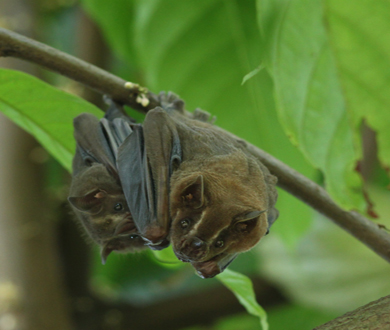Mission
The U.S. Fish and Wildlife Service’s Division of International Conservation works with partners worldwide to conserve fish, wildlife, plants and their habitats, and maintain the integrity of ecological processes beyond our borders, for present and future generations.
Wildlife Without Borders
The Division of International Conservation (DIC), through the Wildlife Without Borders Regional, Species, and Global programs, helps local people to value and conserve the world’s most treasured wildlife and habitats.
Our Organization
We are one of three divisions within the International Affairs Program of the U.S. Fish and Wildlife Service. We have a Chief's office and six Branches.
Our Philosophy
Fish, wildlife, and plants don’t recognize national boundaries. Wildlife and natural resources all over the world are under pressure from human activities such as poaching, illegal harvesting of bushmeat, resource extraction, habitat destruction and pollution. If we want to have any hope at all of saving these important animals and habitats from extinction, we have to work across national boundaries, saving wildlife without borders. In addition, international conservation efforts are of strategic importance to U.S. national security and economic interests because a degraded environment destabilizes communities thus putting people’s livelihoods at risk. This sets the stage for political instability and conflict.
Our Work
The U.S. Fish and Wildlife Service’s Wildlife Without Borders program works with people to conserve nature. We build the capacity of local people to identify, value, and conserve wildlife and their habitats. Wildlife Without Borders has supported international wildlife conservation since 1972. This program allows the Service to address threats to animals and habitats overseas that impact our own wildlife populations and many charismatic species we know and love. We work to reduce human-wildlife conflict, the spread of wildlife diseases, invasive species, bushmeat and other threats. The program partners with other nations at all levels - from grassroots capacity building to applied conservation research, to wildlife management training and improving the coexistence of people and wildlife.

Credit: USFWS
Global Branch. Focusing on species, ecosystems, and emerging and cross cutting issues worldwide, the Wildlife Without Borders Global Program seeks to ensure international cooperation to conserve habitats and endangered species. The Global Branch focuses on international treaties and conventions; partnerships; cross cutting and emerging issues; communications; and grant programs. The Global Branch partners with federal agencies, non-government organizations, private sector corporations, philanthropic institutions, multilateral agencies, and other entities to align priorities for international wildlife conservation and societal impact and to leverage collaborative efforts.
Latin America and Caribbean Branch. The principal goal of the Latin America and the Caribbean Branch is to strengthen the ability of local people and institutions to manage and conserve species, habitats, and ecological processes. The three core strategies implemented by the Latin America and Caribbean Branch are built upon a holistic and inter-disciplinary approach to conservation with a primary emphasis on the social context: building the capacity of key stakeholders through innovative training programs, fostering networks to facilitate learning and collaboration across sites, and enhancing conservation values and behaviors to achieve environmental sustainability.
Mexico Branch. The principal goal of the Mexico Branch is to strengthen Mexico’s capacity to conserve its globally important biological resources. The Branch achieves this through the development of signature initiatives which develop local capacity for biodiversity conservation and management. The Mexico Branch also supports regional approaches, working with the governments of Mexico and Canada, through implementation of the Canada/Mexico/US Trilateral Committee for Wildlife and Ecosystem Conservation and Management MOU, and related legislation.
Near East, South Asia, and Africa Branch. The Near East, South Asia, and Africa Branch’s principle goal is to strengthen the capacity of conservation and natural resource managers, institutions, and communities of the region to conserve biological diversity. This includes species ecosystem conservation. In order to accomplish this goal, the Branch cooperates with domestic and foreign governmental agencies, national and international non-governmental conservation organizations, and universities through legal mandates, international treaties, conventions, protocols, agreements, the Multinational Species Conservation Funds (African and Asian elephant, great apes, rhinoceros and tiger, and marine turtle) and other regional initiatives.
Policy and Partnerships Branch. The Branch of Policy and Partnerships coordinates grant functions and partnership activities to support conservation of wildlife around the globe. The Branch develops and implements grant management policy in accordance with regulatory requirements, while accommodating the logistical concerns of effective on-the-ground conservation work. The Branch also leads strategic planning activities to engage external and internal audiences in supporting and guiding the Service's international conservation work. The Branch seeks to strengthen partnerships with other federal agencies, foreign countries, non-governmental organizations, and other interested entities and individuals in order to enhance sustainability of conservation achievements and maximize conservation project funding through appropriations and matching resources.
Russia and East Asia Branch. The principal goal of the Russia and East Asia Branch is to promote the conservation of wildlife resources in Russia and East Asia. To accomplish this goal, the Branch cooperates with domestic and foreign governmental agencies, national and international non-governmental organizations, universities, and other interested parties. Since 1972, the U.S. Fish & Wildlife Service and its counterpart agencies in the former Soviet Union have studied and conserved wildlife and their habitats. These collaborative efforts have grown to encompass topics such as shared species of migratory birds; fish and marine mammals; refuges and other protected lands; and the vast ecosystem represented by the Bering and Chukchi Seas. Since 1986, the Service has had ongoing cooperation with wildlife managers in China, exchanging ideas for addressing wildlife trade issues as well as wetlands, river, and floodplain management.

